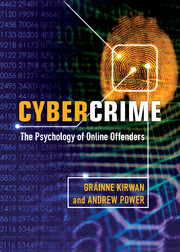Book contents
- Frontmatter
- Contents
- Detailed contents
- List of illustrations
- List of tables
- Preface
- 1 Psychology of cybercrime
- 2 Cybercrimes and cyberlaw
- 3 Hackers
- 4 Malware
- 5 Identity theft and fraud
- 6 Child predation and child pornography online
- 7 Cyberbullying and cyberstalking
- 8 Digital piracy and copyright infringement
- 9 Cyberterrorism
- 10 Crime in virtual worlds
- References
- Index
9 - Cyberterrorism
Published online by Cambridge University Press: 05 July 2013
- Frontmatter
- Contents
- Detailed contents
- List of illustrations
- List of tables
- Preface
- 1 Psychology of cybercrime
- 2 Cybercrimes and cyberlaw
- 3 Hackers
- 4 Malware
- 5 Identity theft and fraud
- 6 Child predation and child pornography online
- 7 Cyberbullying and cyberstalking
- 8 Digital piracy and copyright infringement
- 9 Cyberterrorism
- 10 Crime in virtual worlds
- References
- Index
Summary
Case studies
A city comes under terrorist attack. There are several explosions and people become confused and frightened. Suddenly there is a power blackout. Simultaneously the mobile phone networks stop functioning. Citizens are unable to find out what has happened and cannot contact the emergency services. There is additional loss of life as individuals cannot access medical aid in time. Hackers disrupting the power and communication systems have heightened the fear and confusion arising from a more traditional terror attack.
A young man is unhappy with how a foreign regime is governing his country. Searching online, he discovers that he is not alone. This increases his anger – the fact that there are others who feel the same suggests to him that he is correct to be upset. He finds that he can aid in the fight against this regime by donating funds, providing information or disseminating propaganda. If he wishes, he can even join a terrorist organisation and learn terror-related skills from online videos and websites. He finds that he can contact current members of the organisation via the website, and he feels that finally he has met other people who understand his perspective.
- Type
- Chapter
- Information
- CybercrimeThe Psychology of Online Offenders, pp. 189 - 206Publisher: Cambridge University PressPrint publication year: 2013



